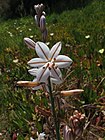Note: This is a project under development. The articles on this wiki are just being initiated and broadly incomplete. You can Help creating new pages.
Difference between revisions of "Asphodelus fistulosus"
| (One intermediate revision by the same user not shown) | |||
| Line 1: | Line 1: | ||
[[File:A. fistulosus-flor-1.jpg|thumb|right]] | [[File:A. fistulosus-flor-1.jpg|thumb|right]] | ||
| + | '''Asphodelus fistulosus''' is an annual to short-lived perennial plant growing from a tuberous rootstock. It produces a cluster of onion-like leaves up to 35cm long and one or more flowering stems up to 70cm tall. | ||
==Uses== | ==Uses== | ||
| − | {{Uses| | + | {{Uses|Atherosclerosis}}. |
==Parts Used== | ==Parts Used== | ||
| − | + | {{Parts Used|Root}}. | |
==Chemical Composition== | ==Chemical Composition== | ||
| − | <ref name="chemical composition"/> | + | The seed oil ofAsphodelus fistulosus (piazi) contains 0.5% myristic, 5.7% palmitic, 3.6% stearic, 33.1% oleic, and 54.9% linoleic acids.<ref name="chemical composition"/> |
==Common names== | ==Common names== | ||
| Line 16: | Line 17: | ||
===Dravya=== | ===Dravya=== | ||
===Rasa=== | ===Rasa=== | ||
| − | |||
===Guna=== | ===Guna=== | ||
| Line 29: | Line 29: | ||
==Habit== | ==Habit== | ||
| − | {{Habit|}} | + | {{Habit|Perennial}} |
==Identification== | ==Identification== | ||
| Line 48: | Line 48: | ||
==Mode of Propagation== | ==Mode of Propagation== | ||
| − | {{Propagation|}} | + | {{Propagation|Seeds}} |
==How to plant/cultivate== | ==How to plant/cultivate== | ||
| − | <ref name="How to plant/cultivate"/> | + | Asphodelus fistulosus is not very cold hardy, tolerating occasional lows to around -5 to -10°c in winter so long as the soil is well-drained. This has contributed to the mistaken belief that it is an annual.<ref name="How to plant/cultivate"/> |
==Commonly seen growing in areas== | ==Commonly seen growing in areas== | ||
| − | {{Commonly seen|}}, {{Commonly seen|}}, {{Commonly seen|}}, {{Commonly seen|}} | + | {{Commonly seen|Dry sandy places}}, {{Commonly seen|Dry rocky places}}, {{Commonly seen|Track-sides}}, {{Commonly seen|Uncultivated ground}} |
==Photo Gallery== | ==Photo Gallery== | ||
| Line 67: | Line 67: | ||
==References== | ==References== | ||
<references> | <references> | ||
| − | <ref name="chemical composition">[Chemistry]</ref> | + | <ref name="chemical composition">[https://aocs.onlinelibrary.wiley.com/doi/abs/10.1007/BF02637982 Chemistry]</ref> |
<ref name="Leaf">[Morphology]</ref> | <ref name="Leaf">[Morphology]</ref> | ||
| − | <ref name="How to plant/cultivate">[Cultivation]</ref> | + | <ref name="How to plant/cultivate">[http://temperate.theferns.info/plant/Asphodelus+fistulosus Cultivation]</ref> |
</references> | </references> | ||
==External Links== | ==External Links== | ||
| − | * [ ] | + | * [https://keyserver.lucidcentral.org/weeds/data/media/Html/asphodelus_fistulosus.htm Asphodelus fistulosus on Lucidcentral.org] |
| − | * [ ] | + | * [https://www.sciencedirect.com/science/article/pii/S0254629911001645 Asphodelus fistulosus on sciencedirect.com] |
| − | + | ||
[[Category:Herbs]] | [[Category:Herbs]] | ||
[[Category:Pages without herbs images]] | [[Category:Pages without herbs images]] | ||
Latest revision as of 15:18, 30 March 2020
Asphodelus fistulosus is an annual to short-lived perennial plant growing from a tuberous rootstock. It produces a cluster of onion-like leaves up to 35cm long and one or more flowering stems up to 70cm tall.
Contents
- 1 Uses
- 2 Parts Used
- 3 Chemical Composition
- 4 Common names
- 5 Properties
- 6 Habit
- 7 Identification
- 8 List of Ayurvedic medicine in which the herb is used
- 9 Where to get the saplings
- 10 Mode of Propagation
- 11 How to plant/cultivate
- 12 Commonly seen growing in areas
- 13 Photo Gallery
- 14 References
- 15 External Links
Uses
Parts Used
Root.
Chemical Composition
The seed oil ofAsphodelus fistulosus (piazi) contains 0.5% myristic, 5.7% palmitic, 3.6% stearic, 33.1% oleic, and 54.9% linoleic acids.[1]
Common names
| Language | Common name |
|---|---|
| Kannada | |
| Hindi | |
| Malayalam | |
| Tamil | |
| Telugu | |
| Marathi | |
| Gujarathi | |
| Punjabi | |
| Kashmiri | |
| Sanskrit | |
| English |
Properties
Reference: Dravya - Substance, Rasa - Taste, Guna - Qualities, Veerya - Potency, Vipaka - Post-digesion effect, Karma - Pharmacological activity, Prabhava - Therepeutics.
Dravya
Rasa
Guna
Veerya
Vipaka
Karma
Prabhava
Habit
Identification
Leaf
| Kind | Shape | Feature |
|---|---|---|
Flower
| Type | Size | Color and composition | Stamen | More information |
|---|---|---|---|---|
| {{{5}}} |
Fruit
| Type | Size | Mass | Appearance | Seeds | More information |
|---|---|---|---|---|---|
Other features
List of Ayurvedic medicine in which the herb is used
Where to get the saplings
Mode of Propagation
How to plant/cultivate
Asphodelus fistulosus is not very cold hardy, tolerating occasional lows to around -5 to -10°c in winter so long as the soil is well-drained. This has contributed to the mistaken belief that it is an annual.[3]
Commonly seen growing in areas
Dry sandy places, Dry rocky places, Track-sides, Uncultivated ground
Photo Gallery
References
- ↑ Chemistry
- ↑ [Morphology]
- ↑ Cultivation
External Links
- Ayurvedic Herbs known to be helpful to treat Atherosclerosis
- Herbs with Root used in medicine
- Habit - Perennial
- Index of Plants which can be propagated by Seeds
- Herbs that are commonly seen in the region of Dry sandy places
- Herbs that are commonly seen in the region of Dry rocky places
- Herbs that are commonly seen in the region of Track-sides
- Herbs that are commonly seen in the region of Uncultivated ground
- Herbs
- Pages without herbs images





